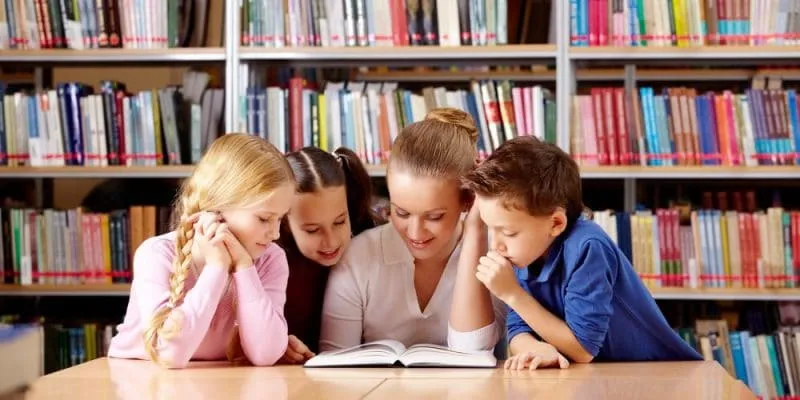Meaning of a Modern Educational Model
The task of educating and teaching others is not easy, there are countless variables that are directly related to learning, from individual aspects such as intelligence, to social aspects such as the number of members in the family. In any case, many of these variables cannot be controlled and do not depend on one. For this reason, today we will talk about one that can be controlled and in fact; has been modified countless times: Educational Models. Learn what they are, how many there are and many more.
What is an Educational Model?
Educational models can be defined as a compendium or set of different theories and pedagogical approaches that seek to guide educators in the development of their study programs and in the systematization of the teaching and learning process.
This definition may seem simple at first glance, but when it is broken down and goes deeper into the elements that define it, we realize that it is quite complex and that it implies the consideration of many other aspects that play an important role within this concept. That said, we will proceed to explain each of these elements in detail so that you can have a better notion of what an educational model means.
In the first place, educational models are not a theory, nor are they specific and isolated knowledge. On the contrary, they refer to a whole body of knowledge, research and theories that support and integrate each other to create a model. Where the model is defined as a line of thought, posture or paradigm that we decide to follow, incorporate or assimilate; because it offers an explanation for a particular phenomenon. That in this case, our phenomenon is teaching and learning. This means that an educational model is a paradigm that contains a series of theories that will serve as a guide to apply teaching and practice teaching.
Now, from a metatheoretical point of view, it is important to clarify the difference between a model and a law. Because a common mistake that educators often have is that they get used to working with a model, to the point of considering it to be unique, perfect and universal. Which is a serious mistake that only leads to stagnation and weakening of teaching. When talking about the laws of nature, physics, chemistry, mathematics, etc.
It is because they are scientifically proven and their veracity has been tested countless times, always obtaining the same results. But the models correspond more to a technique instead of being a law, where what is done is to imitate, reproduce or copy it without having a guarantee that the result will always be what is expected.
Due to this variability, the term «Systematic» is introduced in the definition. Systematization implies the development of a series of ordered steps in order to make a logical sense to increase the chances of achieving the expected result. This means that a model does not only mean having all the theories and applying them without a strategic plan. Rather, it is precisely to develop a coherent action plan that is based on the theoretical bases that support said model.
In this way we reach the ultimate goal or objective of any educational model, which is to transmit knowledge and educate others effectively, quickly and easily. Taking into consideration all the variables involved in learning.
Now, we have said that educational models have a lot of knowledge, theories and pedagogical methods. But not going deeper and explaining what this consists of is leaving a big gap in the definition. All this knowledge has a theoretical scientific component and a practical scientific component (applied science).
The theoretical part of the educational models seeks to explain how the processes and phenomena related to learning in human beings work. For example, learning to read and write can be considered as intuitive skills of human beings that are gradually acquired as a child develops. But after a large amount of research, discoveries have been made that have made it possible to develop learning programs that adapt to the child’s level of cognitive development, so that he or she can acquire these skills optimally at the right time.
Thanks to many studies, it is known that up to the age of seven, children have a greater facility to learn several languages. After this age is exceeded, you can still learn to speak another language, but at a cognitive level it is more complicated. As a consequence of these results, reforms have been made in many countries of the world so that from an early age, children begin to receive classes in a second language (generally English), since this facilitates their learning.
The practical component is related to the development of methods, techniques, programs and pedagogies that allow the theoretical discoveries obtained to be put into practice. For the example above, where you have a child with an intellectual disability. An appropriate solution would be to assign him to a classroom with fewer students, so that he can receive more personalized attention. Also; intelligence evaluations can be carried out to adapt the curricular demands to her cognitive abilities.
Here we mention only two ways of acting in a particular case. But there may be many ways to proceed and the others are not wrong or less effective. This is where the educational model seeks to find a flexible system that is capable of incorporating different theoretical positions to address a phenomenon with the intention of achieving the best performance. Becoming a guide to follow.
On the other hand, educational models are not something new, many authors over the years have developed different systems and models that have been implemented by governments in order to improve education. This has allowed us to realize how sensitive these models are to historical, cultural and social context aspects. For example, 100 years ago there was no problem with a teacher hitting a student’s hand with a ruler to discipline him for interrupting her in class. Today the teacher will most likely be removed from her position for child assault.
The passage of time, together with social, cultural, political, religious changes, etc. And the new discoveries that are made every day about learning cause educational models to become obsolete and be replaced by updated models that incorporate and adapt to the changes of recent years. This is the reason why we can also find so many models created by different authors.
We have already mentioned the importance of theoretical studies in the development of new educational models, where these studies tend to focus above all on the variables that interfere with learning, which should be highlighted; There are too many to be listed in their entirety in this space.
It only remains to say that educational models also focus on working at different levels, both at the micro and macro levels. The macro educational levels are related to the education systems of a country, and include educational reforms, the creation of study programs, the general guidelines that schools, high schools and universities must follow, etc. From there, we find increasingly smaller levels that range from the internal policies of a school, to the educational model used by a teacher (this being the smallest expression of the model).
To get a clear idea of how an educational model works at a micro level, we can use the traditional educational model as an example. Which focuses on the development of study programs with few additional elements (because it does not take into consideration the social differences or the unique characteristics of each individual), nor does it support the intervention of specialists in cases that require it (as in the example of a student with intellectual disability, although it can also be in cases with children with dyslexia, autism, emotional problems, etc.), nor does it take into account many other aspects (for example: the variability in attention spans from one child to another). as it grows, the importance of social coexistence, etc.).
This traditional model only takes as an element in interaction the figure of the teacher, who is the one who performs the active role. The method, which is related to the type of conference. The student, who assumes a passive and receptive role, and the information, which includes all the content and knowledge that will be presented to the students in the form of topics.
Without needing to delve too deeply into this model, some important flaws can be seen. For example, today it is known that the student does not play a passive role, since he interacts and relates actively in his learning. On the other hand, this model does not take into account the influence of social, cultural, political factors, among others. Anyway; it does not take into account many of the variables that are related to learning.
Variables that must be considered in an Educational Model
As indicated in the previous section, education and learning are linked to a large number of variables that interact with the subject, favoring or hindering their ability to learn. Some (as we will see later) cannot be controlled or altered, so a way must be found to deal with it and turn it into a protective factor.
Scientific advances in these variables have had a direct impact on educational models. Since they gave us a greater understanding for the questions of how do we learn? what prevents us from learning? what is the best time to study? Do we all learn in the same way? among many other questions.
Because the number of variables involved in learning are many, it is more practical to group them into categories and describe some briefly so that you have an idea of what they consist of:
- Intrapersonal Variables : It refers to all the variables that are inherent to the subject. For example: intelligence, creativity, attention, motivation, etc. All these variables are related to a person’s ability to learn. So educational models must be aware of this and consider them when developing an action plan. For example: children with intellectual disabilities cannot receive the same education or the same approach as the rest of the normal population. Since instead of accelerating their learning you will only make them stagnate and could generate other additional inconveniences such as social rejection or bullying by their peers.
- Family Variables : It is proven that one of the main predictors of academic success is the family. Aspects such as family dynamics, school support and the importance that the family gives to studies will affect a child’s academic performance. For example: it is very common that in rural families that are mainly dedicated to agriculture, it is not so important to obtain a university degree, this idea can affect the value that the child gives to studies.
- Social Variables : All variables that include the child’s relationship with peers and other people or groups of people.
- Public Policies : Corresponds to the laws and guidelines that a government or state establishes to use in a generalized way on how to educate the people. This mainly includes the use of educational models at a macro level. It is used to determine aspects such as: the development of study programs, the curriculum, evaluation methods, the duration of the academic period, etc.
- Cultural Variables : Culture is an important aspect that can largely determine a child’s academic success. For example: how the Japanese culture aligns the child to study and do their best in school. While in Latin American cultures this happens very little.
In addition to these, there are other variables that educational models must take into account, such as economic variables.
Types of Educational Models
As explained in previous sections, the question arises: what is an educational model according to some authors ? We can give different answers to the question, for this reason, we explain what some of the best-known educational models today consist of.
Traditional Model
Its main emphasis is directed to the development of a study program. The elements that it takes into consideration are minimal since it ignores the impact of social aspects, individual differences, the support of specialists, and poor use is made of evaluation instances related to the study program. At the structural level it is very simple, since it only groups four elements:
- The teacher : He is considered the cornerstone of this model and is the one who plays the active role. It is thought that he has this role because he is the figure in charge of providing the students with the content of the topics, he is the one who handled the information and possesses the knowledge, he is in charge of applying the evaluations, etc.
- The Method : The techniques used by the teacher for students to acquire knowledge. Copy the information in the notebooks, listen to the teacher’s explanations, read the textbooks, etc.
- The Student : In this model the student does not have an important role, in fact; it is considered that he has a passive role, where he is only to be the recipient of information. He is treated as an object of learning and is denied the chance to take an active role.
- The Information : Refers to the topics that the students should see in class, but without making a greater extension or delving into the topics. That is, it is not allowed to explore other sources or areas of knowledge in addition to those established. This means that some teachers develop some topics in greater depth than others, causing different levels of learning in groups of the same academic level.
This model is discontinued and obsolete, as it has many methodological and pedagogical flaws and does not include the scientific/technological advances that were discovered over the years. Its use allows us to better locate ourselves in a particular historical context. Although it must be recognized that it was used to educate several generations.
Ralph Tyler’s Educational Model
The main contribution that this model makes is to implement “objectives” when developing a study program. This results in some planning changes that substantially increase how it is determined if a child has the competencies to move up to the next academic level. The fact of setting objectives implies that evaluation designs or strategies must be developed that allow corroborating that said objectives have been achieved. In turn, this concept changes the functions of the elements that make up the model:
- Teacher : The skills, abilities and knowledge of the teacher go into the background, since he must focus on achieving the objectives that are the ones that direct the content that he must give. On the other hand, in this model the teacher is given support by offering suggested activities to achieve the objectives.
- Method : With the introduction of the objectives, we begin to see a plurality in the methods and techniques used by the same teacher to ensure that students are able to master the content of various topics; that would be inefficient if the same method is always used. In this way, activities appear for both the teacher and the student.
- Student : This is where one of the biggest changes occurs, since the student, who until now had always been a receptive object of information, becomes an active member with the responsibility of carrying out different activities in order to learn. In addition, by implementing objectives, it means that the student from the beginning of the academic year knows the topics that he will have to see and can carry out a search to prepare individually and in advance.
- Information : The topics must follow the guidelines of the objectives, but can be divided into parts to make it easier for the student to digest, and for the teacher to explain. On the other hand, different contents can be joined to form units that must follow a logical order. This avoids giving a class with more difficult topics at the beginning of the year and easier ones at the end. Class planning is also facilitated, giving greater openness to didactics and now a more standardized and homogeneous education can be obtained, greatly reducing the subjectivity that previously existed in the teaching of content; since all the responsibility rested with the teacher.
- Evaluation : A more systematic evaluation is beginning to be used that depends on the study programs and not on the subjectivity of the teacher. Even so, the possibility of the teacher using alternative methods is not restricted, but these must be adjusted to the foreseen objectives.
- Support with Specialists : The teacher as the only unit of the educational system is no longer enough. From this moment on, it is necessary to involve other professionals who have a higher level of technical-pedagogical knowledge for the elaboration of topics, programs, didactics, taxonomies, etc.
- Society : A close link is generated between education and society, due to the fact that many of the objectives suggested by specialists have as their background and reference the needs demanded by society. This implies that as the needs of society change, the intended objectives must also be changed.
Popham-Baker Educational Model
One of the main contributions of this model is to implement the use of systematization more rigorously. To the point of comparing scientific work with that of an educator and mentioning that in both cases the scientific method must be used. This means setting a series of objectives and then developing hypotheses that can confirm that they were actually met. To do this, a design is used that has a series of instruments and evaluation techniques that will allow me to make measurements. The analysis of these data is what allows us to know if my stated objectives are actually met or not.
Something similar happens in the case of the teacher, since they start with learning objectives, then they have to select the instruments, techniques and evaluation methods that best fit the subject to be evaluated. Now they carry out the evaluations and verify the results to verify that the proposed academic objectives are met.
Here you can see the parallelism between the two, although the teacher is not expected to have the same level of rigor and systematization that a scientist should have. Even so, it is expected that there will be a higher level of systematization and that the scientific method be used as a guide in teaching.
This proposal made by Popham-Baker arises at a historical moment in which science is strongly dominated by the positivist paradigm, where the popular belief is that laboratory methods and experiments are the key to finding the answers to all phenomena of science. nature and solve our problems.
Another addition that this model makes in contrast to Tyler’s is to carry out a prior evaluation of the learning objectives in order to have an idea of the knowledge that the student possesses at the beginning of the academic year. An equivalent to the measurement made before doing an experiment to obtain a baseline. Then, at the end of the academic year, the results obtained at the beginning and at the end are contrasted to determine the progress made by the young person during the year.
One drawback of this model was that it put pressure on the teachers to carry out additional evaluations in order to determine that the objectives were met, in addition to having to plan the didactic activities more rigorously and use the evaluation instruments that were considered most effective according to the results. the empirical evidence.
Roger Mager’s Educational Model
This author encourages the teacher to have greater contact and knowledge of the objectives that appear in the academic programs. At this point, the objectives are already divided into general and specific, although we can also find them with other names such as “intermediate” or “operational” depending on the site where you are and the author you base yourself on: with the passing of time, For many years, many authors dedicated themselves to studying the subject of objectives, thus originating multiple nomenclatures and terminologies.
For Mager, the objectives can be stated in two ways, as general objectives and as specific objectives. But those of importance for the teacher are the specific ones, since these are the ones that the teacher develops in depth in the classroom. In addition, it is these objectives that the teacher must plan autonomously how to approach them (what teaching strategies will be used).
The main difference between this model and the previous Popham-Baker model is the way the specific objectives are written and presented. Since they are not only placed together with the general objectives, but they are covered in depth and broken down, adding additional content that facilitates the interpretation for the teacher. In previous models, what happened was that the educators read the objectives quickly but did not notice all the actions and parts that were mentioned in them. This generated as a consequence, that some teachers were not able to distinguish the difference between teaching and evaluating objectives in an adequate way, which triggered inconveniences to achieve the general objectives.
To correct this drawback, Roger Mager’s educational model clearly specified the different elements of a specific objective:
- Presentation : Indicates to whom the specific objective alludes. Who should perform the desired behavior: the student, the practitioner, the participant, etc.
- Behavior : specifically mentions the behavior or action that you want the student or participant to perform. It is always written using active verbs in the infinitive, so there is no room for ambiguity. For example: classify, identify, list, etc.
- Content : the topic or subtopic that is going to be treated is said.
- Conditions : describes the particular circumstances in which the conduct must occur. For example: in a forum, through a map, in the laboratory, using a model, etc.
- Efficacy : it is related to the criteria to make the evaluation, indicating what is the minimum acceptable criterion to consider that it has sufficient competences to pass this topic or sub-topic.
Hilda Taba model
Unlike the previously exposed models, this one by Hilda Taba does not incorporate a new element in particular to highlight. It focuses on synthesizing all the positive elements that its previous versions have in a new educational model. So that the integration produces a better presentation of the contents and the learning activities.
Hilda’s model seeks that the content of the study programs be presented following a logical coherence, but now including a chronological and methodological sequence. This makes it easier for students to receive information from the simplest to the most complex. Starting from the beginning and culminating in the end. Exploring the causes and then studying the effects. Going from the general to the particular, etc.
Another aspect that is modified is the presentation of the activities to be carried out, since teachers must now specify them by relating them to each topic. As with the objectives, the activities must also be sequenced, that is; They should be in chronological order. On the other hand, it is specified in advance which activities will be carried out in group, individual or joint modality.
It should be discriminated which activities are the responsibility of the teachers and which are the responsibility of the students. In turn, spaces must be planned so that the teacher can provide performance feedback, supervise and organize the group; and spaces for students to assume an active role and take a leading role in their learning.
Finnish Educational Model
These models that we have mentioned to you are the basis of educational models used by many countries worldwide. Where each one usually adds or modifies some aspects of those mentioned according to their convenience. Causing each country to differ at least a little in terms of its educational system.
Among the most prestigious educational models worldwide we have that of Finland, which incorporates many of the aspects already mentioned, but which is mainly distinguished by the following elements:
- Being a teacher in Finland is a status symbol, which makes them highly valued.
- Education is free for all its citizens.
- The money invested in education is distributed equitably.
- Schools have a certain level of autonomy.
- Education is personalized and individual differences are taken into account.
- There is a balance between study season and break time.
- Class days are not as long but have a higher level of preparation by the teacher.
- Competition among students is avoided.
- Curiosity and participation are rewarded.
- There is a higher level of parental involvement compared to other countries in the world.

Hello! Let me enthusiastically introduce myself as a dedicated blogger fueled by an intense passion for meticulously crafting insightful and well-researched blogs. My mission revolves around providing you, dear readers, with a veritable treasure trove of invaluable information.







